Critical Evaluation of Negotiation in International Business Context
VerifiedAdded on 2024/05/16
|16
|4207
|338
Essay
AI Summary
This essay provides a critical evaluation of international business negotiation, emphasizing its multidisciplinary nature and the skills required for effective negotiation. It explores various negotiation approaches, including win-lose, compromise, lose-lose, and win-win strategies, and discusses the challenges and importance of international negotiations, using examples like Apple's apology to China and the Microsoft-Nokia deal. The essay also examines theoretical approaches such as game theory and the prisoner's dilemma, and analyzes the relationship between negotiation and cross-cultural differences, using Hofstede's Five Cultural Dimensions Model to compare negotiation styles in China and the USA. It concludes by outlining different negotiation styles, including avoiding, accommodating, and compromising, highlighting the importance of cultural awareness and adaptability in international business negotiations.

INTERNATIONAL BUSINESS
NEGOTIATION
1
NEGOTIATION
1
Paraphrase This Document
Need a fresh take? Get an instant paraphrase of this document with our AI Paraphraser

Table of Contents
INTRODUCTION..........................................................................................................3
BODY............................................................................................................................4
CONCLUSION............................................................................................................14
REFERENCES...........................................................................................................15
2
INTRODUCTION..........................................................................................................3
BODY............................................................................................................................4
CONCLUSION............................................................................................................14
REFERENCES...........................................................................................................15
2
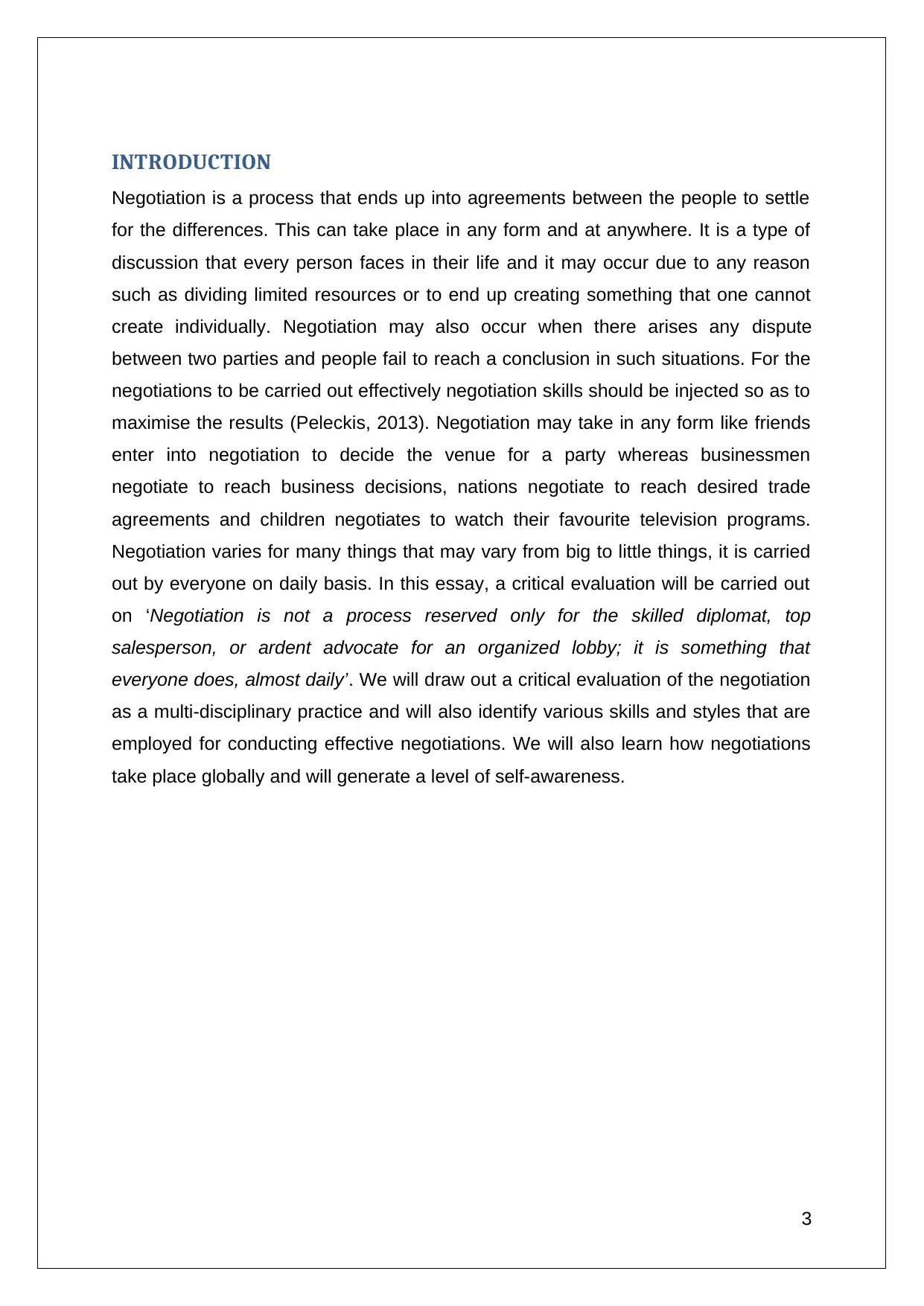
INTRODUCTION
Negotiation is a process that ends up into agreements between the people to settle
for the differences. This can take place in any form and at anywhere. It is a type of
discussion that every person faces in their life and it may occur due to any reason
such as dividing limited resources or to end up creating something that one cannot
create individually. Negotiation may also occur when there arises any dispute
between two parties and people fail to reach a conclusion in such situations. For the
negotiations to be carried out effectively negotiation skills should be injected so as to
maximise the results (Peleckis, 2013). Negotiation may take in any form like friends
enter into negotiation to decide the venue for a party whereas businessmen
negotiate to reach business decisions, nations negotiate to reach desired trade
agreements and children negotiates to watch their favourite television programs.
Negotiation varies for many things that may vary from big to little things, it is carried
out by everyone on daily basis. In this essay, a critical evaluation will be carried out
on ‘Negotiation is not a process reserved only for the skilled diplomat, top
salesperson, or ardent advocate for an organized lobby; it is something that
everyone does, almost daily’. We will draw out a critical evaluation of the negotiation
as a multi-disciplinary practice and will also identify various skills and styles that are
employed for conducting effective negotiations. We will also learn how negotiations
take place globally and will generate a level of self-awareness.
3
Negotiation is a process that ends up into agreements between the people to settle
for the differences. This can take place in any form and at anywhere. It is a type of
discussion that every person faces in their life and it may occur due to any reason
such as dividing limited resources or to end up creating something that one cannot
create individually. Negotiation may also occur when there arises any dispute
between two parties and people fail to reach a conclusion in such situations. For the
negotiations to be carried out effectively negotiation skills should be injected so as to
maximise the results (Peleckis, 2013). Negotiation may take in any form like friends
enter into negotiation to decide the venue for a party whereas businessmen
negotiate to reach business decisions, nations negotiate to reach desired trade
agreements and children negotiates to watch their favourite television programs.
Negotiation varies for many things that may vary from big to little things, it is carried
out by everyone on daily basis. In this essay, a critical evaluation will be carried out
on ‘Negotiation is not a process reserved only for the skilled diplomat, top
salesperson, or ardent advocate for an organized lobby; it is something that
everyone does, almost daily’. We will draw out a critical evaluation of the negotiation
as a multi-disciplinary practice and will also identify various skills and styles that are
employed for conducting effective negotiations. We will also learn how negotiations
take place globally and will generate a level of self-awareness.
3
⊘ This is a preview!⊘
Do you want full access?
Subscribe today to unlock all pages.

Trusted by 1+ million students worldwide
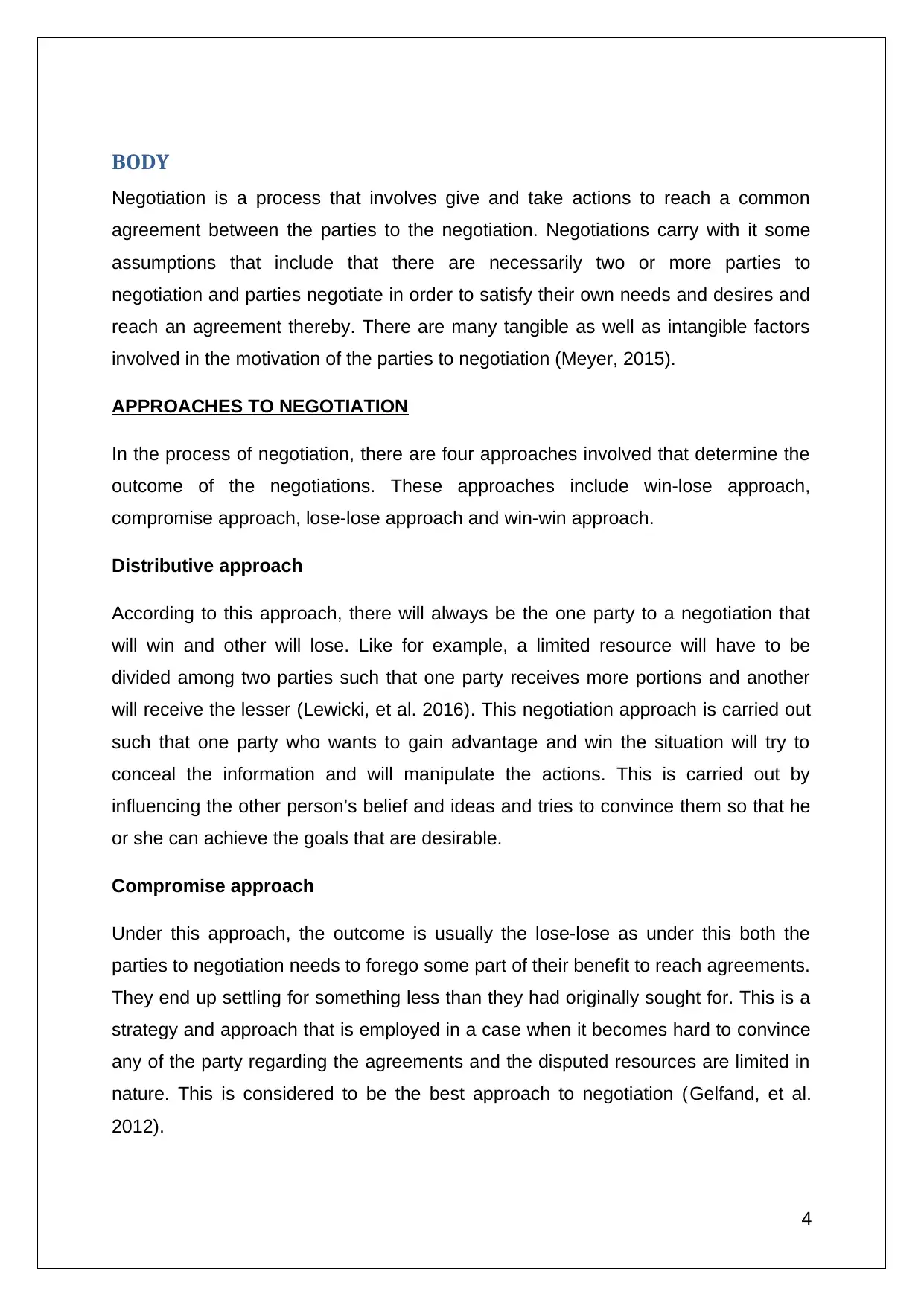
BODY
Negotiation is a process that involves give and take actions to reach a common
agreement between the parties to the negotiation. Negotiations carry with it some
assumptions that include that there are necessarily two or more parties to
negotiation and parties negotiate in order to satisfy their own needs and desires and
reach an agreement thereby. There are many tangible as well as intangible factors
involved in the motivation of the parties to negotiation (Meyer, 2015).
APPROACHES TO NEGOTIATION
In the process of negotiation, there are four approaches involved that determine the
outcome of the negotiations. These approaches include win-lose approach,
compromise approach, lose-lose approach and win-win approach.
Distributive approach
According to this approach, there will always be the one party to a negotiation that
will win and other will lose. Like for example, a limited resource will have to be
divided among two parties such that one party receives more portions and another
will receive the lesser (Lewicki, et al. 2016). This negotiation approach is carried out
such that one party who wants to gain advantage and win the situation will try to
conceal the information and will manipulate the actions. This is carried out by
influencing the other person’s belief and ideas and tries to convince them so that he
or she can achieve the goals that are desirable.
Compromise approach
Under this approach, the outcome is usually the lose-lose as under this both the
parties to negotiation needs to forego some part of their benefit to reach agreements.
They end up settling for something less than they had originally sought for. This is a
strategy and approach that is employed in a case when it becomes hard to convince
any of the party regarding the agreements and the disputed resources are limited in
nature. This is considered to be the best approach to negotiation (Gelfand, et al.
2012).
4
Negotiation is a process that involves give and take actions to reach a common
agreement between the parties to the negotiation. Negotiations carry with it some
assumptions that include that there are necessarily two or more parties to
negotiation and parties negotiate in order to satisfy their own needs and desires and
reach an agreement thereby. There are many tangible as well as intangible factors
involved in the motivation of the parties to negotiation (Meyer, 2015).
APPROACHES TO NEGOTIATION
In the process of negotiation, there are four approaches involved that determine the
outcome of the negotiations. These approaches include win-lose approach,
compromise approach, lose-lose approach and win-win approach.
Distributive approach
According to this approach, there will always be the one party to a negotiation that
will win and other will lose. Like for example, a limited resource will have to be
divided among two parties such that one party receives more portions and another
will receive the lesser (Lewicki, et al. 2016). This negotiation approach is carried out
such that one party who wants to gain advantage and win the situation will try to
conceal the information and will manipulate the actions. This is carried out by
influencing the other person’s belief and ideas and tries to convince them so that he
or she can achieve the goals that are desirable.
Compromise approach
Under this approach, the outcome is usually the lose-lose as under this both the
parties to negotiation needs to forego some part of their benefit to reach agreements.
They end up settling for something less than they had originally sought for. This is a
strategy and approach that is employed in a case when it becomes hard to convince
any of the party regarding the agreements and the disputed resources are limited in
nature. This is considered to be the best approach to negotiation (Gelfand, et al.
2012).
4
Paraphrase This Document
Need a fresh take? Get an instant paraphrase of this document with our AI Paraphraser
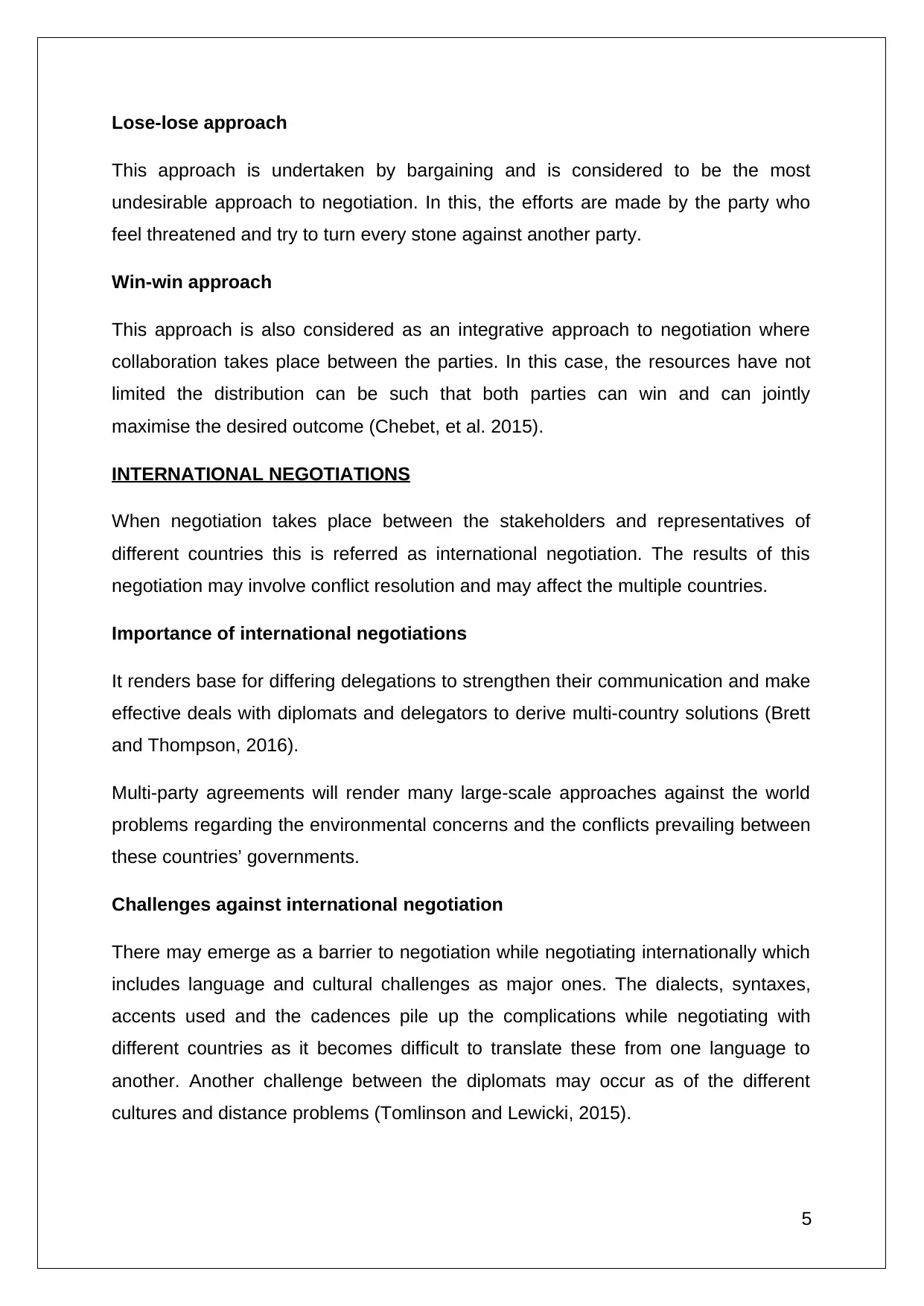
Lose-lose approach
This approach is undertaken by bargaining and is considered to be the most
undesirable approach to negotiation. In this, the efforts are made by the party who
feel threatened and try to turn every stone against another party.
Win-win approach
This approach is also considered as an integrative approach to negotiation where
collaboration takes place between the parties. In this case, the resources have not
limited the distribution can be such that both parties can win and can jointly
maximise the desired outcome (Chebet, et al. 2015).
INTERNATIONAL NEGOTIATIONS
When negotiation takes place between the stakeholders and representatives of
different countries this is referred as international negotiation. The results of this
negotiation may involve conflict resolution and may affect the multiple countries.
Importance of international negotiations
It renders base for differing delegations to strengthen their communication and make
effective deals with diplomats and delegators to derive multi-country solutions (Brett
and Thompson, 2016).
Multi-party agreements will render many large-scale approaches against the world
problems regarding the environmental concerns and the conflicts prevailing between
these countries’ governments.
Challenges against international negotiation
There may emerge as a barrier to negotiation while negotiating internationally which
includes language and cultural challenges as major ones. The dialects, syntaxes,
accents used and the cadences pile up the complications while negotiating with
different countries as it becomes difficult to translate these from one language to
another. Another challenge between the diplomats may occur as of the different
cultures and distance problems (Tomlinson and Lewicki, 2015).
5
This approach is undertaken by bargaining and is considered to be the most
undesirable approach to negotiation. In this, the efforts are made by the party who
feel threatened and try to turn every stone against another party.
Win-win approach
This approach is also considered as an integrative approach to negotiation where
collaboration takes place between the parties. In this case, the resources have not
limited the distribution can be such that both parties can win and can jointly
maximise the desired outcome (Chebet, et al. 2015).
INTERNATIONAL NEGOTIATIONS
When negotiation takes place between the stakeholders and representatives of
different countries this is referred as international negotiation. The results of this
negotiation may involve conflict resolution and may affect the multiple countries.
Importance of international negotiations
It renders base for differing delegations to strengthen their communication and make
effective deals with diplomats and delegators to derive multi-country solutions (Brett
and Thompson, 2016).
Multi-party agreements will render many large-scale approaches against the world
problems regarding the environmental concerns and the conflicts prevailing between
these countries’ governments.
Challenges against international negotiation
There may emerge as a barrier to negotiation while negotiating internationally which
includes language and cultural challenges as major ones. The dialects, syntaxes,
accents used and the cadences pile up the complications while negotiating with
different countries as it becomes difficult to translate these from one language to
another. Another challenge between the diplomats may occur as of the different
cultures and distance problems (Tomlinson and Lewicki, 2015).
5
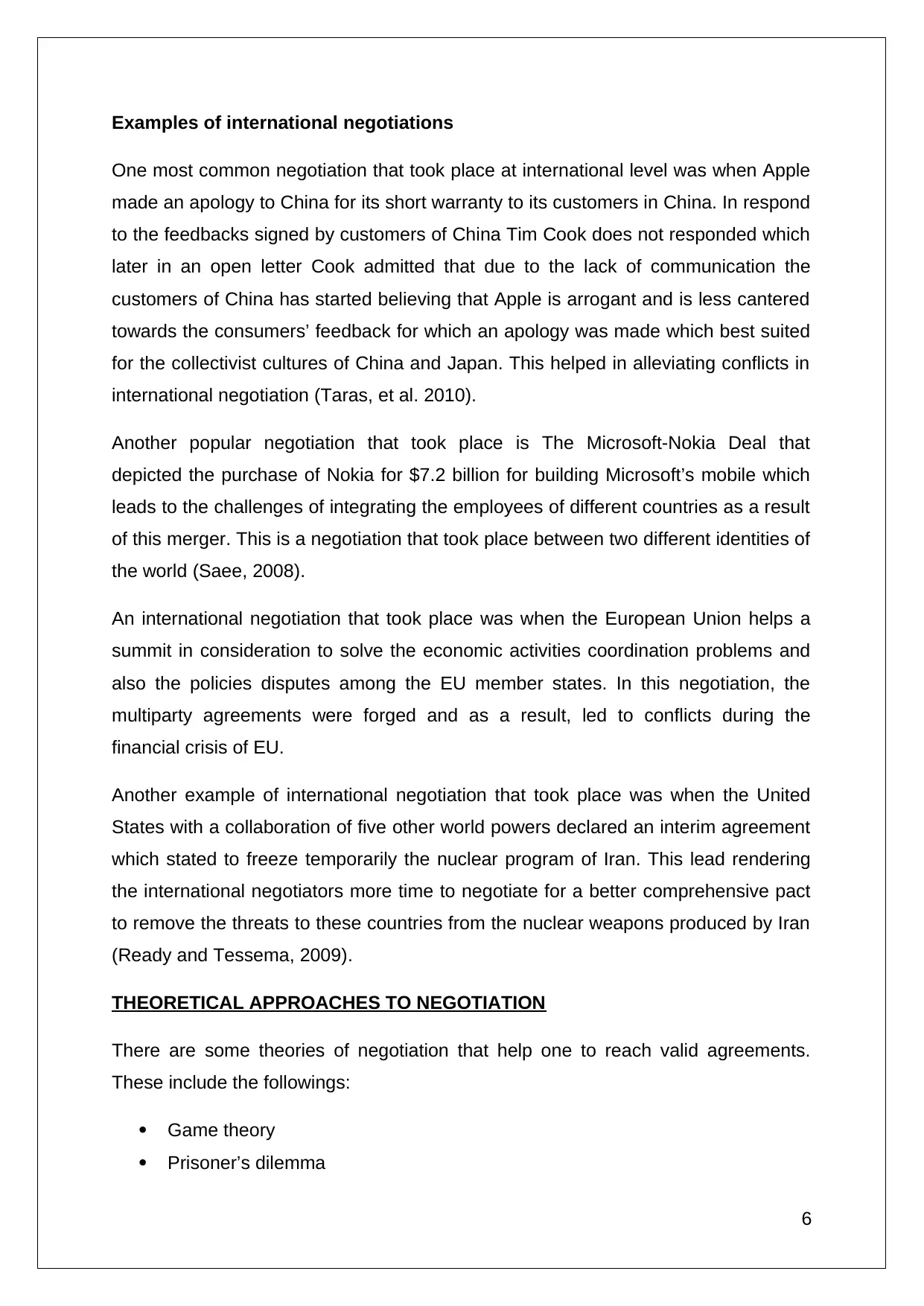
Examples of international negotiations
One most common negotiation that took place at international level was when Apple
made an apology to China for its short warranty to its customers in China. In respond
to the feedbacks signed by customers of China Tim Cook does not responded which
later in an open letter Cook admitted that due to the lack of communication the
customers of China has started believing that Apple is arrogant and is less cantered
towards the consumers’ feedback for which an apology was made which best suited
for the collectivist cultures of China and Japan. This helped in alleviating conflicts in
international negotiation (Taras, et al. 2010).
Another popular negotiation that took place is The Microsoft-Nokia Deal that
depicted the purchase of Nokia for $7.2 billion for building Microsoft’s mobile which
leads to the challenges of integrating the employees of different countries as a result
of this merger. This is a negotiation that took place between two different identities of
the world (Saee, 2008).
An international negotiation that took place was when the European Union helps a
summit in consideration to solve the economic activities coordination problems and
also the policies disputes among the EU member states. In this negotiation, the
multiparty agreements were forged and as a result, led to conflicts during the
financial crisis of EU.
Another example of international negotiation that took place was when the United
States with a collaboration of five other world powers declared an interim agreement
which stated to freeze temporarily the nuclear program of Iran. This lead rendering
the international negotiators more time to negotiate for a better comprehensive pact
to remove the threats to these countries from the nuclear weapons produced by Iran
(Ready and Tessema, 2009).
THEORETICAL APPROACHES TO NEGOTIATION
There are some theories of negotiation that help one to reach valid agreements.
These include the followings:
Game theory
Prisoner’s dilemma
6
One most common negotiation that took place at international level was when Apple
made an apology to China for its short warranty to its customers in China. In respond
to the feedbacks signed by customers of China Tim Cook does not responded which
later in an open letter Cook admitted that due to the lack of communication the
customers of China has started believing that Apple is arrogant and is less cantered
towards the consumers’ feedback for which an apology was made which best suited
for the collectivist cultures of China and Japan. This helped in alleviating conflicts in
international negotiation (Taras, et al. 2010).
Another popular negotiation that took place is The Microsoft-Nokia Deal that
depicted the purchase of Nokia for $7.2 billion for building Microsoft’s mobile which
leads to the challenges of integrating the employees of different countries as a result
of this merger. This is a negotiation that took place between two different identities of
the world (Saee, 2008).
An international negotiation that took place was when the European Union helps a
summit in consideration to solve the economic activities coordination problems and
also the policies disputes among the EU member states. In this negotiation, the
multiparty agreements were forged and as a result, led to conflicts during the
financial crisis of EU.
Another example of international negotiation that took place was when the United
States with a collaboration of five other world powers declared an interim agreement
which stated to freeze temporarily the nuclear program of Iran. This lead rendering
the international negotiators more time to negotiate for a better comprehensive pact
to remove the threats to these countries from the nuclear weapons produced by Iran
(Ready and Tessema, 2009).
THEORETICAL APPROACHES TO NEGOTIATION
There are some theories of negotiation that help one to reach valid agreements.
These include the followings:
Game theory
Prisoner’s dilemma
6
⊘ This is a preview!⊘
Do you want full access?
Subscribe today to unlock all pages.

Trusted by 1+ million students worldwide
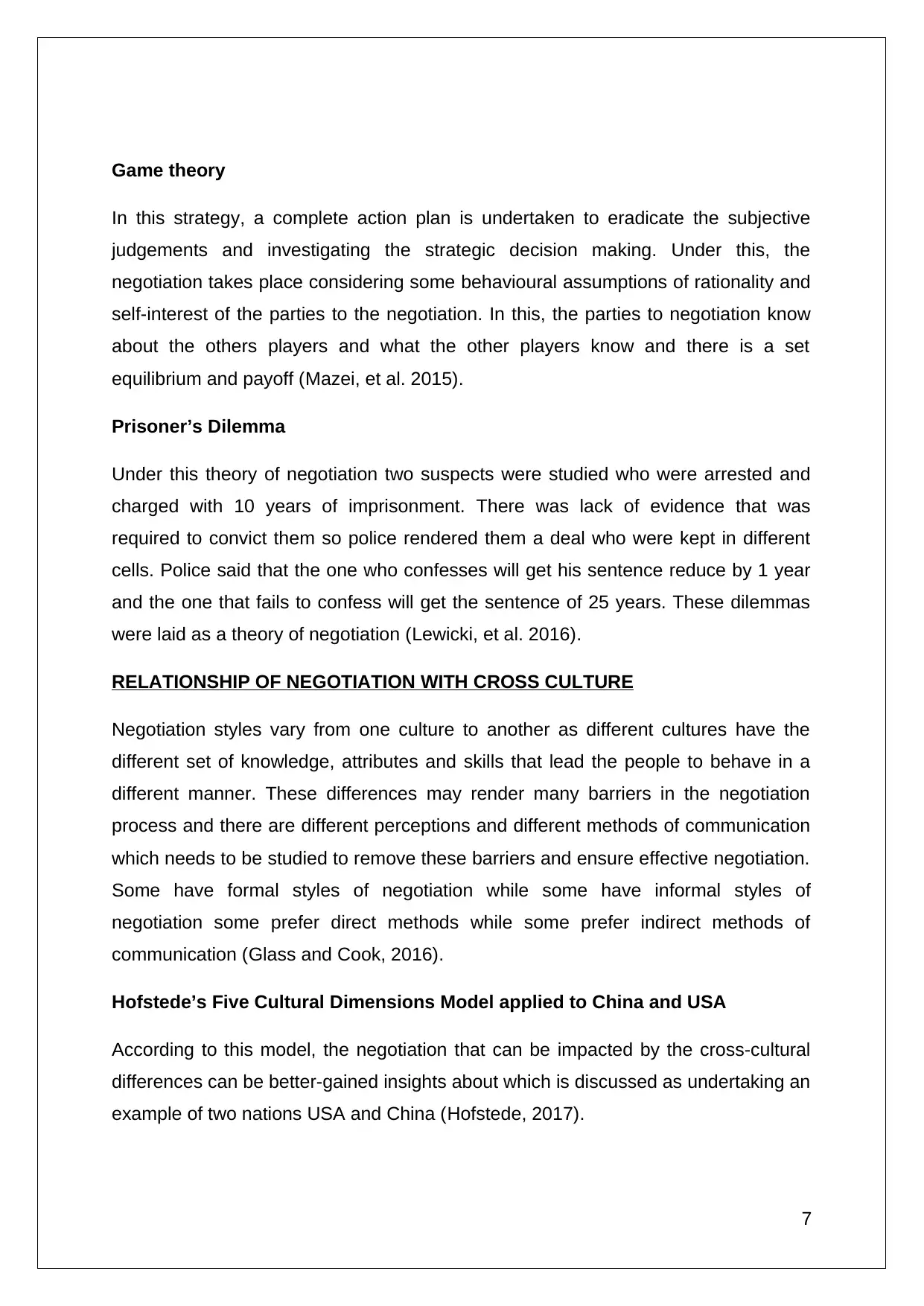
Game theory
In this strategy, a complete action plan is undertaken to eradicate the subjective
judgements and investigating the strategic decision making. Under this, the
negotiation takes place considering some behavioural assumptions of rationality and
self-interest of the parties to the negotiation. In this, the parties to negotiation know
about the others players and what the other players know and there is a set
equilibrium and payoff (Mazei, et al. 2015).
Prisoner’s Dilemma
Under this theory of negotiation two suspects were studied who were arrested and
charged with 10 years of imprisonment. There was lack of evidence that was
required to convict them so police rendered them a deal who were kept in different
cells. Police said that the one who confesses will get his sentence reduce by 1 year
and the one that fails to confess will get the sentence of 25 years. These dilemmas
were laid as a theory of negotiation (Lewicki, et al. 2016).
RELATIONSHIP OF NEGOTIATION WITH CROSS CULTURE
Negotiation styles vary from one culture to another as different cultures have the
different set of knowledge, attributes and skills that lead the people to behave in a
different manner. These differences may render many barriers in the negotiation
process and there are different perceptions and different methods of communication
which needs to be studied to remove these barriers and ensure effective negotiation.
Some have formal styles of negotiation while some have informal styles of
negotiation some prefer direct methods while some prefer indirect methods of
communication (Glass and Cook, 2016).
Hofstede’s Five Cultural Dimensions Model applied to China and USA
According to this model, the negotiation that can be impacted by the cross-cultural
differences can be better-gained insights about which is discussed as undertaking an
example of two nations USA and China (Hofstede, 2017).
7
In this strategy, a complete action plan is undertaken to eradicate the subjective
judgements and investigating the strategic decision making. Under this, the
negotiation takes place considering some behavioural assumptions of rationality and
self-interest of the parties to the negotiation. In this, the parties to negotiation know
about the others players and what the other players know and there is a set
equilibrium and payoff (Mazei, et al. 2015).
Prisoner’s Dilemma
Under this theory of negotiation two suspects were studied who were arrested and
charged with 10 years of imprisonment. There was lack of evidence that was
required to convict them so police rendered them a deal who were kept in different
cells. Police said that the one who confesses will get his sentence reduce by 1 year
and the one that fails to confess will get the sentence of 25 years. These dilemmas
were laid as a theory of negotiation (Lewicki, et al. 2016).
RELATIONSHIP OF NEGOTIATION WITH CROSS CULTURE
Negotiation styles vary from one culture to another as different cultures have the
different set of knowledge, attributes and skills that lead the people to behave in a
different manner. These differences may render many barriers in the negotiation
process and there are different perceptions and different methods of communication
which needs to be studied to remove these barriers and ensure effective negotiation.
Some have formal styles of negotiation while some have informal styles of
negotiation some prefer direct methods while some prefer indirect methods of
communication (Glass and Cook, 2016).
Hofstede’s Five Cultural Dimensions Model applied to China and USA
According to this model, the negotiation that can be impacted by the cross-cultural
differences can be better-gained insights about which is discussed as undertaking an
example of two nations USA and China (Hofstede, 2017).
7
Paraphrase This Document
Need a fresh take? Get an instant paraphrase of this document with our AI Paraphraser
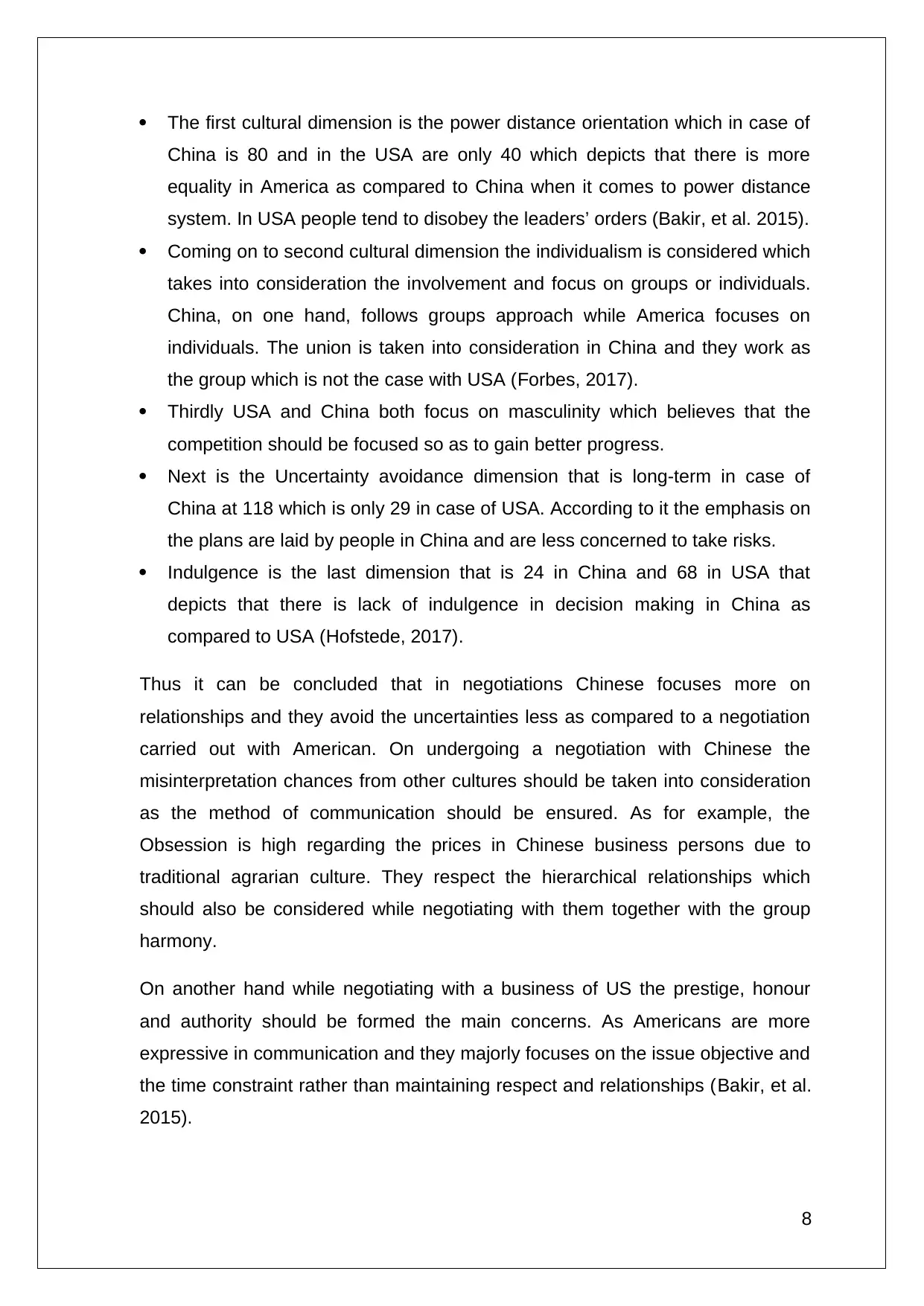
The first cultural dimension is the power distance orientation which in case of
China is 80 and in the USA are only 40 which depicts that there is more
equality in America as compared to China when it comes to power distance
system. In USA people tend to disobey the leaders’ orders (Bakir, et al. 2015).
Coming on to second cultural dimension the individualism is considered which
takes into consideration the involvement and focus on groups or individuals.
China, on one hand, follows groups approach while America focuses on
individuals. The union is taken into consideration in China and they work as
the group which is not the case with USA (Forbes, 2017).
Thirdly USA and China both focus on masculinity which believes that the
competition should be focused so as to gain better progress.
Next is the Uncertainty avoidance dimension that is long-term in case of
China at 118 which is only 29 in case of USA. According to it the emphasis on
the plans are laid by people in China and are less concerned to take risks.
Indulgence is the last dimension that is 24 in China and 68 in USA that
depicts that there is lack of indulgence in decision making in China as
compared to USA (Hofstede, 2017).
Thus it can be concluded that in negotiations Chinese focuses more on
relationships and they avoid the uncertainties less as compared to a negotiation
carried out with American. On undergoing a negotiation with Chinese the
misinterpretation chances from other cultures should be taken into consideration
as the method of communication should be ensured. As for example, the
Obsession is high regarding the prices in Chinese business persons due to
traditional agrarian culture. They respect the hierarchical relationships which
should also be considered while negotiating with them together with the group
harmony.
On another hand while negotiating with a business of US the prestige, honour
and authority should be formed the main concerns. As Americans are more
expressive in communication and they majorly focuses on the issue objective and
the time constraint rather than maintaining respect and relationships (Bakir, et al.
2015).
8
China is 80 and in the USA are only 40 which depicts that there is more
equality in America as compared to China when it comes to power distance
system. In USA people tend to disobey the leaders’ orders (Bakir, et al. 2015).
Coming on to second cultural dimension the individualism is considered which
takes into consideration the involvement and focus on groups or individuals.
China, on one hand, follows groups approach while America focuses on
individuals. The union is taken into consideration in China and they work as
the group which is not the case with USA (Forbes, 2017).
Thirdly USA and China both focus on masculinity which believes that the
competition should be focused so as to gain better progress.
Next is the Uncertainty avoidance dimension that is long-term in case of
China at 118 which is only 29 in case of USA. According to it the emphasis on
the plans are laid by people in China and are less concerned to take risks.
Indulgence is the last dimension that is 24 in China and 68 in USA that
depicts that there is lack of indulgence in decision making in China as
compared to USA (Hofstede, 2017).
Thus it can be concluded that in negotiations Chinese focuses more on
relationships and they avoid the uncertainties less as compared to a negotiation
carried out with American. On undergoing a negotiation with Chinese the
misinterpretation chances from other cultures should be taken into consideration
as the method of communication should be ensured. As for example, the
Obsession is high regarding the prices in Chinese business persons due to
traditional agrarian culture. They respect the hierarchical relationships which
should also be considered while negotiating with them together with the group
harmony.
On another hand while negotiating with a business of US the prestige, honour
and authority should be formed the main concerns. As Americans are more
expressive in communication and they majorly focuses on the issue objective and
the time constraint rather than maintaining respect and relationships (Bakir, et al.
2015).
8
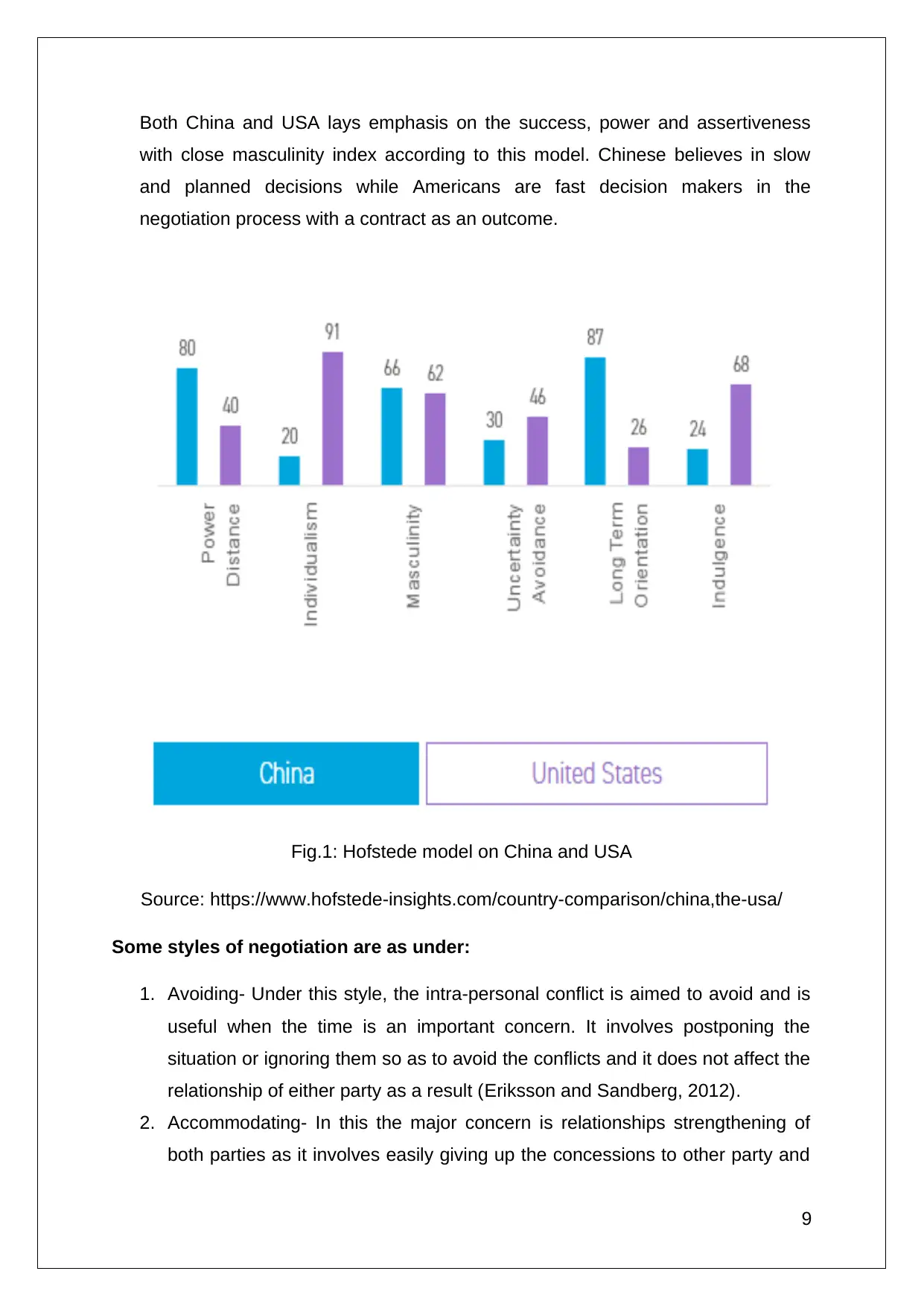
Both China and USA lays emphasis on the success, power and assertiveness
with close masculinity index according to this model. Chinese believes in slow
and planned decisions while Americans are fast decision makers in the
negotiation process with a contract as an outcome.
Fig.1: Hofstede model on China and USA
Source: https://www.hofstede-insights.com/country-comparison/china,the-usa/
Some styles of negotiation are as under:
1. Avoiding- Under this style, the intra-personal conflict is aimed to avoid and is
useful when the time is an important concern. It involves postponing the
situation or ignoring them so as to avoid the conflicts and it does not affect the
relationship of either party as a result (Eriksson and Sandberg, 2012).
2. Accommodating- In this the major concern is relationships strengthening of
both parties as it involves easily giving up the concessions to other party and
9
with close masculinity index according to this model. Chinese believes in slow
and planned decisions while Americans are fast decision makers in the
negotiation process with a contract as an outcome.
Fig.1: Hofstede model on China and USA
Source: https://www.hofstede-insights.com/country-comparison/china,the-usa/
Some styles of negotiation are as under:
1. Avoiding- Under this style, the intra-personal conflict is aimed to avoid and is
useful when the time is an important concern. It involves postponing the
situation or ignoring them so as to avoid the conflicts and it does not affect the
relationship of either party as a result (Eriksson and Sandberg, 2012).
2. Accommodating- In this the major concern is relationships strengthening of
both parties as it involves easily giving up the concessions to other party and
9
⊘ This is a preview!⊘
Do you want full access?
Subscribe today to unlock all pages.

Trusted by 1+ million students worldwide
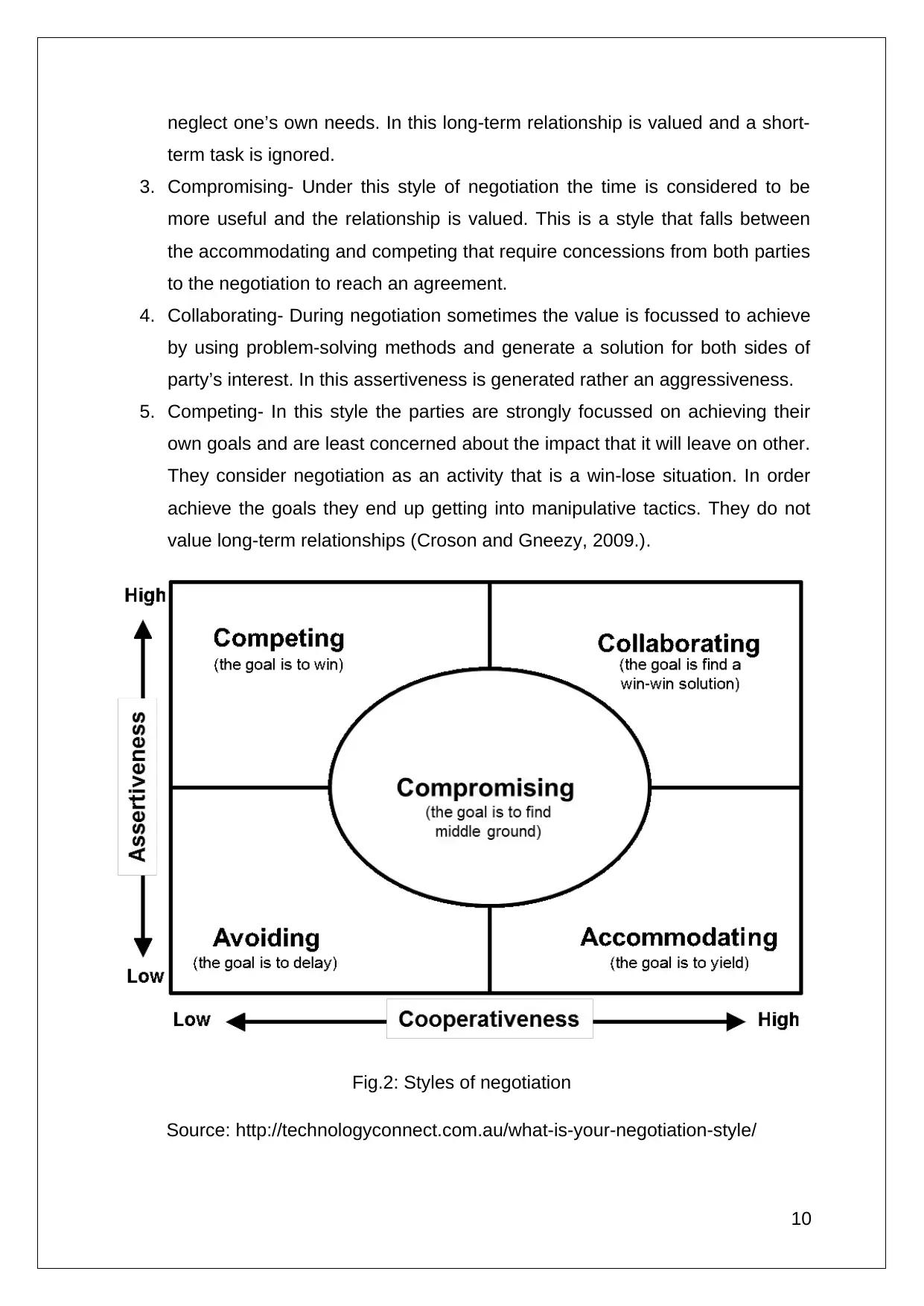
neglect one’s own needs. In this long-term relationship is valued and a short-
term task is ignored.
3. Compromising- Under this style of negotiation the time is considered to be
more useful and the relationship is valued. This is a style that falls between
the accommodating and competing that require concessions from both parties
to the negotiation to reach an agreement.
4. Collaborating- During negotiation sometimes the value is focussed to achieve
by using problem-solving methods and generate a solution for both sides of
party’s interest. In this assertiveness is generated rather an aggressiveness.
5. Competing- In this style the parties are strongly focussed on achieving their
own goals and are least concerned about the impact that it will leave on other.
They consider negotiation as an activity that is a win-lose situation. In order
achieve the goals they end up getting into manipulative tactics. They do not
value long-term relationships (Croson and Gneezy, 2009.).
Fig.2: Styles of negotiation
Source: http://technologyconnect.com.au/what-is-your-negotiation-style/
10
term task is ignored.
3. Compromising- Under this style of negotiation the time is considered to be
more useful and the relationship is valued. This is a style that falls between
the accommodating and competing that require concessions from both parties
to the negotiation to reach an agreement.
4. Collaborating- During negotiation sometimes the value is focussed to achieve
by using problem-solving methods and generate a solution for both sides of
party’s interest. In this assertiveness is generated rather an aggressiveness.
5. Competing- In this style the parties are strongly focussed on achieving their
own goals and are least concerned about the impact that it will leave on other.
They consider negotiation as an activity that is a win-lose situation. In order
achieve the goals they end up getting into manipulative tactics. They do not
value long-term relationships (Croson and Gneezy, 2009.).
Fig.2: Styles of negotiation
Source: http://technologyconnect.com.au/what-is-your-negotiation-style/
10
Paraphrase This Document
Need a fresh take? Get an instant paraphrase of this document with our AI Paraphraser
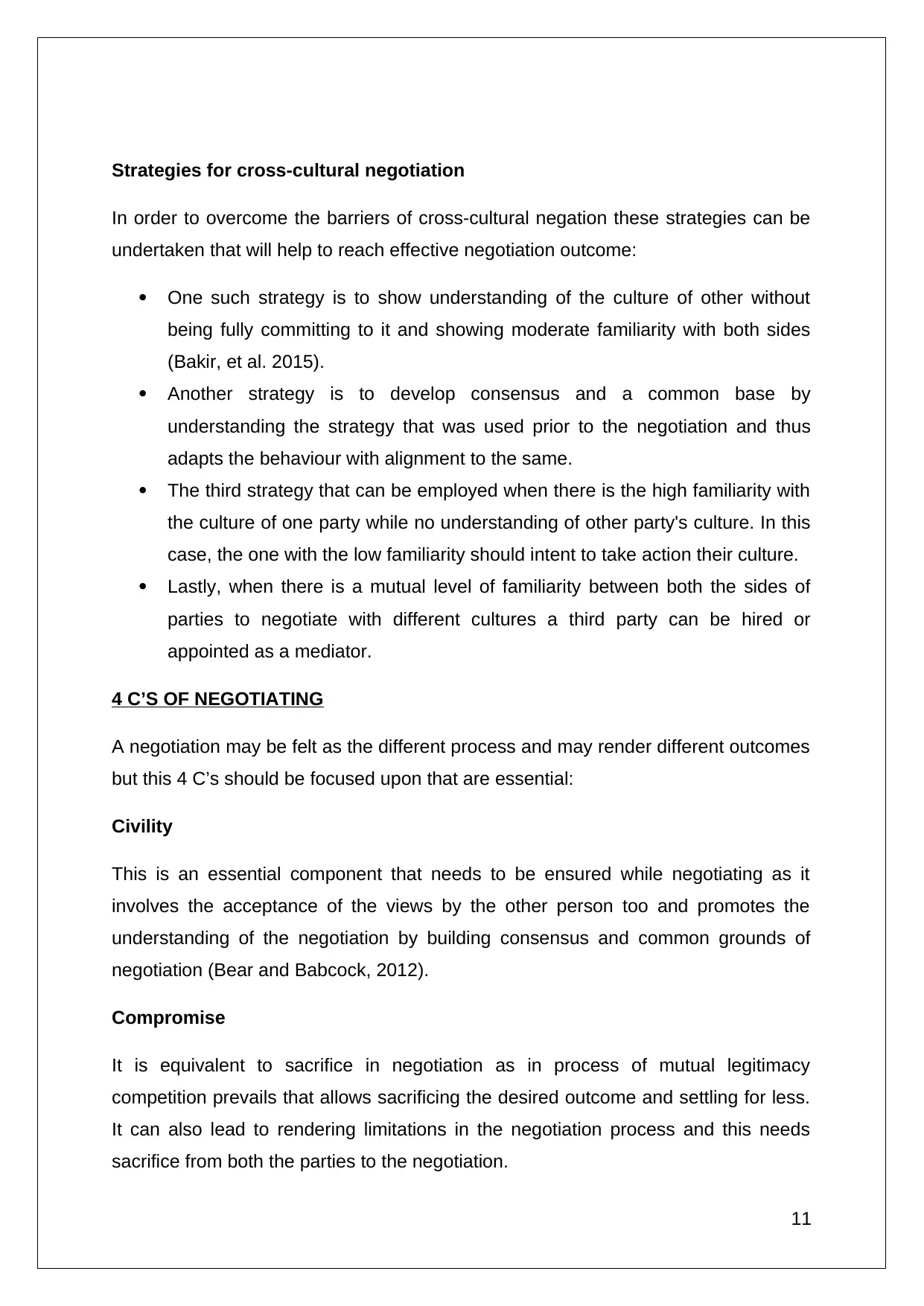
Strategies for cross-cultural negotiation
In order to overcome the barriers of cross-cultural negation these strategies can be
undertaken that will help to reach effective negotiation outcome:
One such strategy is to show understanding of the culture of other without
being fully committing to it and showing moderate familiarity with both sides
(Bakir, et al. 2015).
Another strategy is to develop consensus and a common base by
understanding the strategy that was used prior to the negotiation and thus
adapts the behaviour with alignment to the same.
The third strategy that can be employed when there is the high familiarity with
the culture of one party while no understanding of other party's culture. In this
case, the one with the low familiarity should intent to take action their culture.
Lastly, when there is a mutual level of familiarity between both the sides of
parties to negotiate with different cultures a third party can be hired or
appointed as a mediator.
4 C’S OF NEGOTIATING
A negotiation may be felt as the different process and may render different outcomes
but this 4 C’s should be focused upon that are essential:
Civility
This is an essential component that needs to be ensured while negotiating as it
involves the acceptance of the views by the other person too and promotes the
understanding of the negotiation by building consensus and common grounds of
negotiation (Bear and Babcock, 2012).
Compromise
It is equivalent to sacrifice in negotiation as in process of mutual legitimacy
competition prevails that allows sacrificing the desired outcome and settling for less.
It can also lead to rendering limitations in the negotiation process and this needs
sacrifice from both the parties to the negotiation.
11
In order to overcome the barriers of cross-cultural negation these strategies can be
undertaken that will help to reach effective negotiation outcome:
One such strategy is to show understanding of the culture of other without
being fully committing to it and showing moderate familiarity with both sides
(Bakir, et al. 2015).
Another strategy is to develop consensus and a common base by
understanding the strategy that was used prior to the negotiation and thus
adapts the behaviour with alignment to the same.
The third strategy that can be employed when there is the high familiarity with
the culture of one party while no understanding of other party's culture. In this
case, the one with the low familiarity should intent to take action their culture.
Lastly, when there is a mutual level of familiarity between both the sides of
parties to negotiate with different cultures a third party can be hired or
appointed as a mediator.
4 C’S OF NEGOTIATING
A negotiation may be felt as the different process and may render different outcomes
but this 4 C’s should be focused upon that are essential:
Civility
This is an essential component that needs to be ensured while negotiating as it
involves the acceptance of the views by the other person too and promotes the
understanding of the negotiation by building consensus and common grounds of
negotiation (Bear and Babcock, 2012).
Compromise
It is equivalent to sacrifice in negotiation as in process of mutual legitimacy
competition prevails that allows sacrificing the desired outcome and settling for less.
It can also lead to rendering limitations in the negotiation process and this needs
sacrifice from both the parties to the negotiation.
11
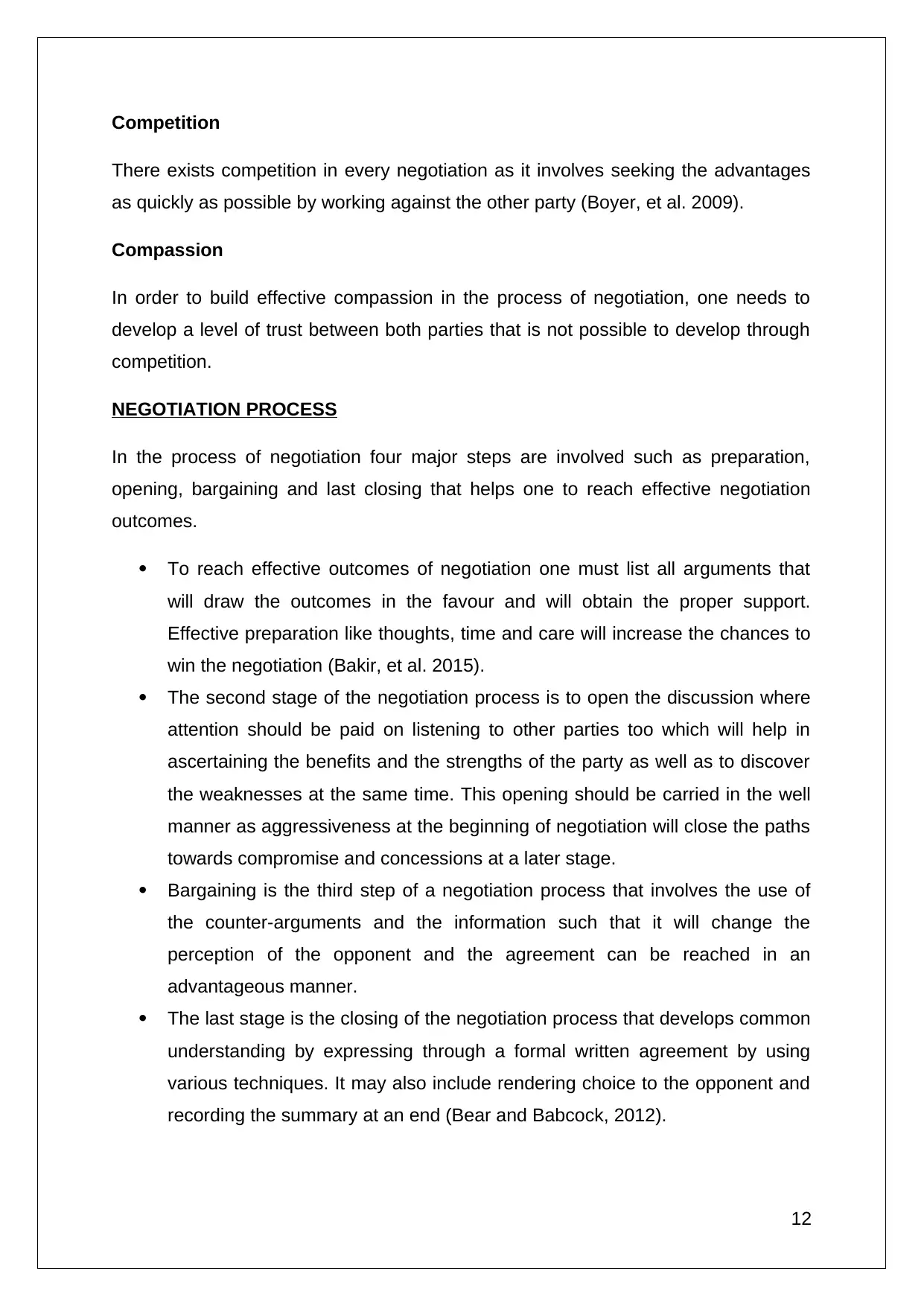
Competition
There exists competition in every negotiation as it involves seeking the advantages
as quickly as possible by working against the other party (Boyer, et al. 2009).
Compassion
In order to build effective compassion in the process of negotiation, one needs to
develop a level of trust between both parties that is not possible to develop through
competition.
NEGOTIATION PROCESS
In the process of negotiation four major steps are involved such as preparation,
opening, bargaining and last closing that helps one to reach effective negotiation
outcomes.
To reach effective outcomes of negotiation one must list all arguments that
will draw the outcomes in the favour and will obtain the proper support.
Effective preparation like thoughts, time and care will increase the chances to
win the negotiation (Bakir, et al. 2015).
The second stage of the negotiation process is to open the discussion where
attention should be paid on listening to other parties too which will help in
ascertaining the benefits and the strengths of the party as well as to discover
the weaknesses at the same time. This opening should be carried in the well
manner as aggressiveness at the beginning of negotiation will close the paths
towards compromise and concessions at a later stage.
Bargaining is the third step of a negotiation process that involves the use of
the counter-arguments and the information such that it will change the
perception of the opponent and the agreement can be reached in an
advantageous manner.
The last stage is the closing of the negotiation process that develops common
understanding by expressing through a formal written agreement by using
various techniques. It may also include rendering choice to the opponent and
recording the summary at an end (Bear and Babcock, 2012).
12
There exists competition in every negotiation as it involves seeking the advantages
as quickly as possible by working against the other party (Boyer, et al. 2009).
Compassion
In order to build effective compassion in the process of negotiation, one needs to
develop a level of trust between both parties that is not possible to develop through
competition.
NEGOTIATION PROCESS
In the process of negotiation four major steps are involved such as preparation,
opening, bargaining and last closing that helps one to reach effective negotiation
outcomes.
To reach effective outcomes of negotiation one must list all arguments that
will draw the outcomes in the favour and will obtain the proper support.
Effective preparation like thoughts, time and care will increase the chances to
win the negotiation (Bakir, et al. 2015).
The second stage of the negotiation process is to open the discussion where
attention should be paid on listening to other parties too which will help in
ascertaining the benefits and the strengths of the party as well as to discover
the weaknesses at the same time. This opening should be carried in the well
manner as aggressiveness at the beginning of negotiation will close the paths
towards compromise and concessions at a later stage.
Bargaining is the third step of a negotiation process that involves the use of
the counter-arguments and the information such that it will change the
perception of the opponent and the agreement can be reached in an
advantageous manner.
The last stage is the closing of the negotiation process that develops common
understanding by expressing through a formal written agreement by using
various techniques. It may also include rendering choice to the opponent and
recording the summary at an end (Bear and Babcock, 2012).
12
⊘ This is a preview!⊘
Do you want full access?
Subscribe today to unlock all pages.

Trusted by 1+ million students worldwide
1 out of 16
Related Documents
Your All-in-One AI-Powered Toolkit for Academic Success.
+13062052269
info@desklib.com
Available 24*7 on WhatsApp / Email
![[object Object]](/_next/static/media/star-bottom.7253800d.svg)
Unlock your academic potential
Copyright © 2020–2025 A2Z Services. All Rights Reserved. Developed and managed by ZUCOL.




